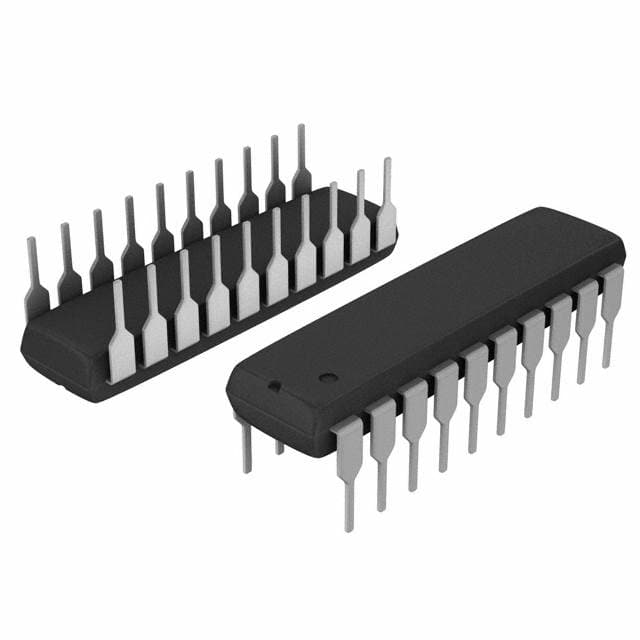Consulte las especificaciones para obtener detalles del producto.

Encyclopedia Entry: 74F245PC
Product Overview
Category
The 74F245PC belongs to the category of integrated circuits (ICs) and specifically falls under the family of bus transceivers.
Use
This IC is commonly used for bidirectional data transfer between different buses or systems. It enables the seamless exchange of data between two separate digital systems, ensuring efficient communication.
Characteristics
- Bidirectional data transfer capability
- High-speed operation
- Low power consumption
- Wide operating voltage range
- Robust design for reliable performance
Package
The 74F245PC is typically available in a 20-pin dual in-line package (DIP). This package provides ease of installation and compatibility with standard IC sockets.
Essence
The essence of the 74F245PC lies in its ability to facilitate the smooth transmission of data between different digital systems, enhancing overall system efficiency and communication reliability.
Packaging/Quantity
The 74F245PC is commonly packaged in reels or tubes, containing multiple units per package. The exact quantity may vary depending on the supplier or manufacturer.
Specifications
- Supply Voltage: 4.5V to 5.5V
- Operating Temperature Range: -40°C to +85°C
- Input/Output Compatibility: TTL-compatible
- Maximum Data Rate: 120 MHz
- Output Drive Capability: ±24 mA
Detailed Pin Configuration
The 74F245PC features a total of 20 pins, each serving a specific function. The pin configuration is as follows:
- A1
- B1
- GND
- A2
- B2
- DIR
- OE
- B3
- B4
- B5
- B6
- B7
- B8
- VCC
- A8
- A7
- A6
- A5
- A4
- A3
Functional Features
- Bidirectional data transfer between two buses or systems
- Direction control (DIR) pin for selecting the data flow direction
- Output enable (OE) pin for enabling/disabling the outputs
- TTL-compatible inputs and outputs for easy integration with other digital systems
- High-speed operation allows for efficient data transmission
Advantages and Disadvantages
Advantages
- Enables seamless bidirectional data transfer
- Wide operating voltage range enhances compatibility
- Robust design ensures reliable performance
- Low power consumption for energy efficiency
- High-speed operation for efficient data transmission
Disadvantages
- Limited number of input/output pins may restrict certain applications
- Requires careful consideration of signal timing to avoid data corruption
Working Principles
The 74F245PC operates based on a combination of internal logic gates and transistors. It utilizes the DIR pin to control the direction of data flow, while the OE pin enables or disables the outputs. The IC's internal circuitry ensures proper data transfer between the input and output pins, allowing bidirectional communication.
Detailed Application Field Plans
The 74F245PC finds extensive use in various applications, including but not limited to: - Microprocessor interfacing - Data communication systems - Industrial automation - Embedded systems - Networking equipment
Detailed and Complete Alternative Models
There are several alternative models available that offer similar functionality to the 74F245PC. Some notable alternatives include: - SN74LVC245A - CD74HCT245E - MC74ACT245DW
These alternatives provide comparable bidirectional data transfer capabilities and can be considered as substitutes depending on specific requirements.
In conclusion, the 74F245PC is a versatile bus transceiver IC that enables efficient bidirectional data transfer between different digital systems. Its robust design, low power consumption, and high-speed operation make it suitable for various applications in the field of digital communication and interfacing.
Word Count: 515
Enumere 10 preguntas y respuestas comunes relacionadas con la aplicación de 74F245PC en soluciones técnicas
Sure! Here are 10 common questions and answers related to the application of 74F245PC in technical solutions:
Q: What is the 74F245PC? A: The 74F245PC is a bidirectional octal bus transceiver integrated circuit (IC) that allows bidirectional transfer of data between two buses.
Q: What is the maximum voltage rating for the 74F245PC? A: The maximum voltage rating for the 74F245PC is typically around 5.5 volts.
Q: Can the 74F245PC be used for level shifting between different voltage domains? A: Yes, the 74F245PC can be used for level shifting as it supports bidirectional voltage translation.
Q: How many data lines can the 74F245PC handle? A: The 74F245PC can handle up to 8 data lines, making it suitable for applications involving parallel data transfer.
Q: Does the 74F245PC require external pull-up or pull-down resistors? A: No, the 74F245PC has built-in internal pull-up and pull-down resistors, eliminating the need for external ones.
Q: Can the 74F245PC operate at high speeds? A: Yes, the 74F245PC is designed to operate at high-speeds, making it suitable for applications requiring fast data transfer.
Q: Is the 74F245PC compatible with both TTL and CMOS logic levels? A: Yes, the 74F245PC is compatible with both TTL and CMOS logic levels, allowing it to interface with various types of logic circuits.
Q: Can the 74F245PC be used for bus isolation? A: Yes, the 74F245PC can be used for bus isolation as it provides bidirectional data transfer and supports tri-state operation.
Q: What is the power supply voltage range for the 74F245PC? A: The power supply voltage range for the 74F245PC typically ranges from 4.5 volts to 5.5 volts.
Q: Are there any specific precautions to consider when using the 74F245PC? A: It is important to ensure proper decoupling capacitors are used near the power supply pins of the 74F245PC to minimize noise and voltage fluctuations.
Please note that these answers are general and may vary depending on the specific application and datasheet of the 74F245PC.

